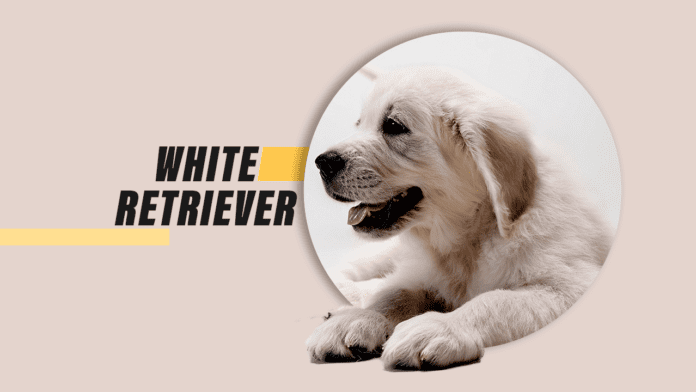Golden retrievers are treasured for their radiant coats, ranging from deep honey hues to the strikingly pale shade often described as “white retriever.” The allure of this lighter coat color has piqued the curiosity of many enthusiasts and potential dog owners.
You might wonder why some golden retrievers boast such a pristine white coat compared to their more traditionally colored counterparts. Is there a secret within their genes?.
Delving into this canine enigma reveals that genetics play a pivotal role in determining a retriever’s coat coloration. Among these dogs, an intricate dance of genetic factors is responsible for the spectrum we adore—from glistening golds to pearly whites.
This article will explore the fascinating science behind these captivating shades, providing you with insights into why your future four-legged friend may sport such an elegant snowy mantle.
Through understanding the genetic interplay that paints our furry friends’ coats with such unique brushstrokes, you’ll gain clarity on what sets white golden retrievers apart. Are you ready for a journey through DNA strands and pigment pathways? Let’s uncover the mystery together!
Overview of White Golden Retrievers
Embarking on the journey to understand White Golden Retrievers, we uncover a world where creamy coats radiate charm and embody a calm temperament that is nothing short of enchanting.
These ethereal canines are more than just their striking appearance; they carry a rich genetic tapestry interwoven with fascinating history and distinctive traits that set them apart from the conventional golden hue of their counterparts.
Characteristics of White Golden Retrievers
White Golden Retrievers shine with smart, loyal, and calm temperaments. They captivate hearts with their stunning cream-colored coats and sturdy structures.
- Glossy Light-Colored Coats: The coat of a White Golden Retriever is its most striking feature. It’s not pure white but a pale shade of cream. This beautiful fur is thick and water-repellent, perfect for outdoor play.
- Loyal Companions: Known for unwavering loyalty, these dogs form strong bonds with their families. They are often by your side, offering companionship and affection.
- Intelligent Canines: White Golden Retrievers are very smart. They learn commands quickly during obedience training sessions.
- Calm Demeanor: These canines possess a naturally calm temperament. They are not quick to bark or become agitated, making them great pets in various settings.
- Strong Physique: Their bodies are well-built and muscular. This helps them excel in activities requiring strength, such as dog sports or hiking.
- Friendly Personality: A friendly nature is inherent to White Golden Retrievers; they get along splendidly with adults, children, and other pets.
- Eager Learners: Positive reinforcement works wonders in teaching these dogs new tricks or behavior patterns because they love praise and rewards.
- Health Consciousness: Breeders often select adult dogs for outstanding health to ensure puppies inherit robust genes for longevity and decreased risk of disease.
- Training Ready: At an early age, White Golden Retriever puppies start learning good manners through potty training, crate training, leash walking, and socialization exercises.
Differences from the “Golden”, Golden Retriever


White Golden Retrievers stand out from their golden-colored cousins. Their unique coat color and physical features set them apart.
- Coat Shade: The most obvious difference is the coat shade. White retrievers have a light cream to almost white coat, while traditional golden retrievers display a range of golden hues.
- Origin: White Golden Retrievers are often bred in Europe and Australia, whereas the classic goldens are more associated with American breeding lines.
- Breed Standards: The American Kennel Club (AKC) prefers darker shades for show dogs. In contrast, dog shows in Europe may favor the lighter coats of white retrievers.
- Size and Build: These dogs might differ slightly in size and build. White retrievers can be stockier, with broader heads and shorter noses.
- Eye Shape: You’ll notice that white retrievers often have rounder, darker eyes compared to the slanted or almond-shaped eyes of typical goldens.
- Temperament: All golden retrievers are known for their friendly nature, but many believe that white goldens have an even calmer demeanor.
- Health Perspective: Breeders suggest that white Golden Retrievers might have fewer skin problems due to their lighter coat pigmentation.
The History of the White Golden Retriever
The white golden retriever has roots in Europe and Scotland from the 1800s. Lord Tweedmouth played a huge role in developing this dog breed. He crossed his yellow retriever with a tweed water spaniel to create a skilled hunting dog.
These dogs also had great temperaments, making them perfect family pets.
Over time, the breed split into American and English types. The English cream golden retrievers came about for their excellence in sports and as gundogs. They were known for their lighter coats and strong builds.
By 1903, The Kennel Club recognized these dogs as part of the “Flat Coats: Golden” category. Their popularity grew across Europe and eventually reached the United States, where they became loved by many dog enthusiasts. Additionally, you can also read about iTeaching the techniques to your pet.
The Genetics Behind the White Golden Retriever Coat Color
White Golden Retrievers get their unique coat color from genetics. Their fur is controlled by two types of pigment, pheomelanin for red or yellow hues and eumelanin for black or brown shades.
In these dogs, a certain gene affects how much eumelanin they produce. This gene has a variation known as the “chinchilla” effect, which dilutes the color to a pale cream or white instead of gold.
It’s all about the DNA that decides if a Golden Retriever will be white. Breeders can’t make puppies with this coat color unless both parents have the right genes. They must have recessive genes that create less eumelanin pigment in their fur.
When two such genes meet, they give birth to pups with stunningly white coats—this is what makes them rare and sought after.
Comparison Between White and English Cream Golden Retrievers
Exploring the nuances between White and English Cream Golden Retrievers reveals intriguing distinctions. Breed enthusiasts often debate these variations, each carrying its unique charm and characteristics.
| White Golden Retriever | English Cream Golden Retriever |
|---|---|
| Cream to light blonde coat color | Light cream to near-white coat color |
| Developed in the United States | Has European roots, specifically from Britain |
| Typically has a broader head | Features a more chiseled, refined facial structure |
| coat may darken with age | coat color generally remains consistent throughout life |
| Eyes are often dark brown | Eyes may appear lighter, matching the coat |
| Known for its outgoing and friendly temperament | Shares the same calm and friendly temperament |
| Requires frequent exercise and mental stimulation | Equally energetic, needing similar levels of activity |
Both varieties stem from the same genetic lineage. Yet, their cosmetic differences reflect the breed standards set by their respective regions. English Cream Golden Retrievers often come with a slightly higher price tag, attributed to their perceived rarity and allure in the United States. However, Snowy Pines ensures that, regardless of the shade, their focus remains on breeding the healthiest retrievers with ideal temperaments.
Common Misconceptions About White Retrievers


Dispelling myths is crucial, especially when it comes to the enigmatic white retriever—a breed surrounded by a constellation of misconceptions. From their rarity to supposed hypoallergenic qualities, we’ll shine a light on the truths that are often overshadowed by well-trodden but misleading tales.
Are White Golden Retrievers Rare?
White Golden Retrievers might seem unique, but they are not rare. Often called “English Cream Golden Retrievers,” these dogs are known for their light-colored coats and friendly personalities.
People love them for their calm ways and gentle spirits.
Many people think a white retriever is hard to find because of its coat. In reality, they’re quite popular among dog lovers. The name can be misleading, though—it’s really about the pale shade of cream in their fur, not pure white.
They come from the same family as traditional golden retrievers; it’s just that breeders select for lighter coloration over generations.
Are English Golden Retrievers Hypoallergenic?
English Golden Retrievers are not hypoallergenic. They can spread allergens that might cause allergic reactions in some people. Their soft, thick coats shed dander and fur, which carry the proteins known to trigger allergies.
If you have dog allergies, it’s important to know that these beautiful dogs could still make you sneeze or itch. Regular grooming helps reduce shedding, but it won’t eliminate allergens completely.
Choosing an English Golden Retriever means preparing for some extra cleaning around the house. Vacuum often and keep air filters clean to cut down on airborne dander. Though they’re not a match for allergic owners, their friendly nature makes them incredibly popular among families who don’t mind a bit of fluff!
The Difference Between Labs and Golden Retrievers
Labs and golden retrievers look different and act differently too. If you’re thinking about getting a dog, it’s important to know these differences.
- Body Shape: Labs have a stocky, strong build, while golden retrievers are slender with graceful lines.
- Coat Texture: Labs boast a short, dense coat that’s water-resistant. Golden retrievers have long, fluffy coats that are also water-repellent.
- Coat Color: Labradors come in black, chocolate, or yellow shades. Golden retrievers’ coats range from light cream to a rich gold.
- Shedding: Both breeds shed, but golden retrievers usually shed more because of their longer hair.
- Grooming Needs: Golden retriever coats need more brushing to prevent tangles. Labs require less grooming overall.
- Lifespan: English cream Golden Retrievers tend to live longer than their American counterparts and Labrador Retrievers.
- Head Shape: A lab’s head is broader with a pronounced stop; a golden retriever’s head is narrower with gentle contours.
- History: The division between American and English golden retrievers dates back to the late 1800s. This was after the import of the Labradors to Europe and the US.
- Function: Historically, labs were bred for retrieving game in water. Golden retreivers were developed for hunting on land.
White Retriever Dog Price
White Retriever puppies can be quite expensive. You might pay around $2,500 for one with no breeding rights. If you want the right to breed your dog, it could cost you up to $3,500 from some breeders.
The price often reflects the breeder’s reputation and the care they put into raising their dogs.
Snowy Pines sets a higher price tag for their English Cream Golden Retriever puppies. Depending on how well-trained a puppy is, prices range from $7,500 to an impressive $17,500. Plus, they offer a five-year guarantee against genetic defects, which adds more value to your investment in these purebred companions.
Conclusion
Understanding the genetics of white Golden Retrievers sheds light on their stunning coats and debunks myths about these dogs. We learned that genes play a key role in their color, health, and temperament.
These insights help dog lovers make informed choices when welcoming a furry friend into their home. Remember, knowledge about your pet’s background means better care for them!


![How Much is Lil Baby’s Net Worth in 2024 [Latest Info] Lil Baby Net Worth](https://www.wariat.org/wp-content/uploads/2024/03/Lil-Baby-Net-Worth-150x150.jpg)
![Rob Lowe Net Worth Speculation in 2024 [Comparative Analysis] Rob Lowe Net Worth](https://www.wariat.org/wp-content/uploads/2024/03/Rob-Lowe-Net-Worth-150x150.jpg)


